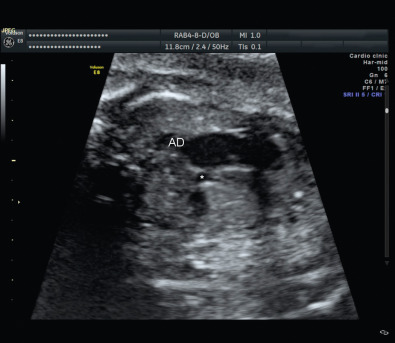Abstract
Interruption of the aortic arch (IAA) is a very rare congenital heart disease (CHD); the initial sign raising suspicion is disproportion of the left and right ventricles. It can be very difficult to distinguish from aortic coarctation (AoC). The appearance of the aorta can vary according to the type of IAA. There is a high association with other cardiac and extracardiac anomalies. In isolated IAA, the prognosis is generally good, but long-term complications at the aortic repair site are possible.
Keywords
congenital heart defect, aortic coarctation, aortic interruption
Disease
Definition
IAA is characterized by the lack of continuity between the ascending and descending aorta.
Prevalence and Epidemiology
IAA accounts for 0.1% of all prenatally detected congenital heart diseases (CHDs) and 0.2% to 1% of postnatal CHDs, affecting 1 : 300,000 newborns. IAA has a high prevalence of associated anomalies, including:
- •
Extracardiac abnormalities: central nervous system, urinary, and gastrointestinal malformations are the most frequently associated (present in 30% of cases).
- •
Chromosomal abnormalities: type B IAA has a high association (60% to 70%) with 22q11 microdeletion.
- •
Cardiac anomalies: associated cardiac anomalies are common, especially truncus arteriosus (10% to 20%), left ventricular outflow tract obstruction (10% to 16%), aortic valvular stenosis (10%), aortopulmonary window, double-outlet right ventricle (5%), and transposition of great arteries (4% to 6%).
Etiology and Pathophysiology
IAA is due to a lack of connection between the proximal and distal portion of the aortic arch. The etiology is unknown, although it has been related to genetic and chromosomal abnormalities, especially 22q11 microdeletion. Depending on the level of the interrupted site, three types of IAA have been described, as follows :
- 1.
The interruption is distal to the left subclavian artery (30% to 40%); this form is more frequent in cases with associated truncus arteriosus.
- 2.
The interruption is between the left carotid and left subclavian artery (50% to 60%).
- 3.
Proximal interruption, between the innominate and left carotid artery (5% to 10%).
Manifestations of Disease
Imaging Technique and Findings
Ultrasound.
The key finding that raises suspicion of IAA is the disproportion of the left and right ventricles ( Fig. 83.1 ).
- •
Ventricular disproportion can be identified on the four-chamber view, especially in IAA type A and C. The right ventricle appears larger than the left, and greater right ventricular flow is identified with color Doppler. This sign is less evident in type B IAA because there is frequently a large malaligned VSD that balances right and left flow.
- •
There is disproportion of the sizes of the outflow tracts. The pulmonary artery is disproportionally bigger than the aortic root.
- •
The three-vessel and trachea view shows reduced diameter or unidentifiable aorta, with pronounced asymmetry between the aortic arch and pulmonary artery ( Fig. 83.2 ).

Fig. 83.2
Abnormal three-vessel and trachea view. The aortic arch (*) stops its course. It is not possible to identify the confluence between the arterial duct (AD) and the aortic isthmus.
Stay updated, free articles. Join our Telegram channel

Full access? Get Clinical Tree








